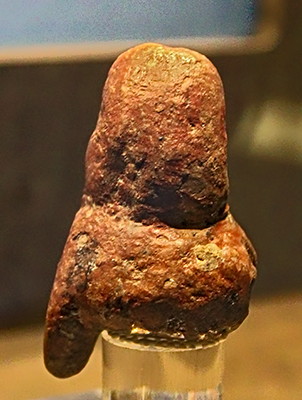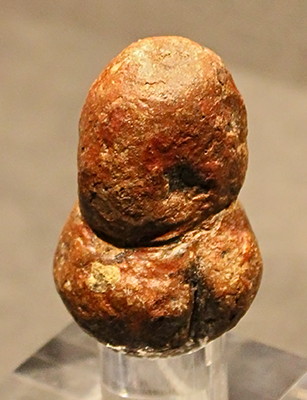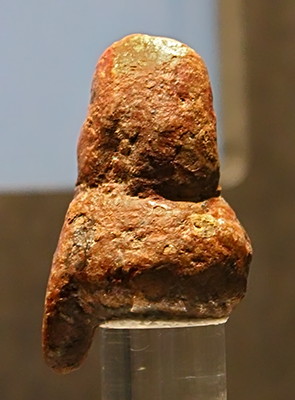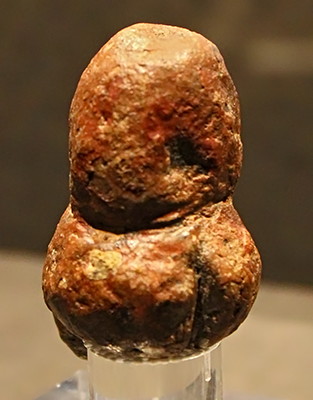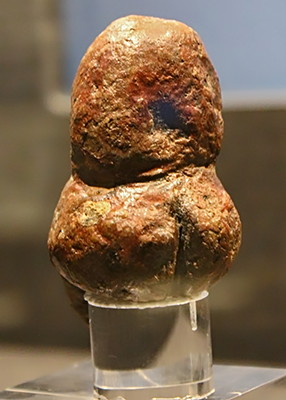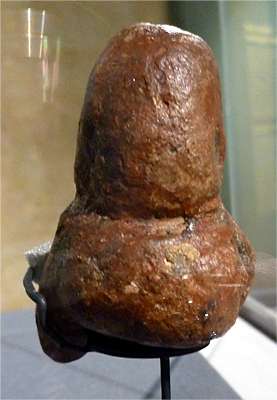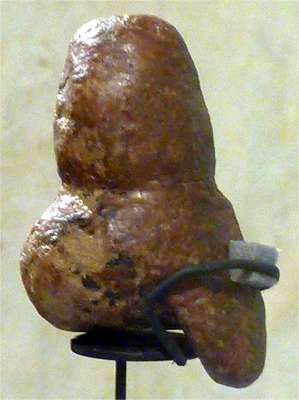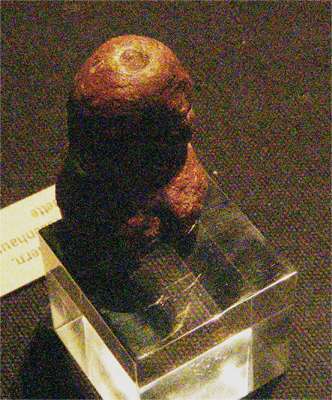Back to Don's Maps
Back to Venus figures from the Stone Age
The Venus of Die Rote von Mauern - the Red Venus from the Weinberghöhlen near Mauern
Die Rote von Mauern is a venus statuette in limestone, 27 000 years old, covered with red ochre when found at the Weinberghöhlen caves near Mauern, Bavaria. Lothar Zotz, on 24th August 1948, found the 72 mm tall limestone venus figure on the outer slope between cavities two and three of the Weinberghöhlen. During 1937-38, 1947-49, 1967 and 1974 bone fragments and traces of mammoth, cave bear, woolly rhinoceros, reindeer and 20 other different animals were found at the caves, as well as high quality Blattspitzen or leaf points of Mousterian / Neanderthal origin.
The Weinberghöhlen Caves near Mauern, Bavaria, in which the Rote von Mauern was found.
Photo: jokreu via Panoramio

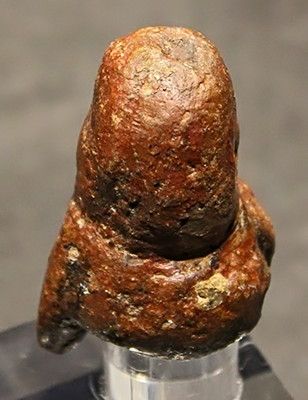
Die Rote von Mauern
A venus statuette from Bavaria, 27 000 years old called "Die Rote von Mauern" ("The red one of Mauern")
'Die Rote von Mauern' ein Fruchtbarkeitsidol aus Kalkstein, Weinberghöhlen bei Mauern, Lkr. Neuburg a. d. Donau. Ca. 25 000 v. Chr.
The red venus of Mauern is a fertility object of limestone, from the Weinberghöhlen caves near the vineyards of Mauern, district of Neuburg an der Donau. Approx. 25 000 BC
Photo: Ralph Frenken
Source: original, exhibited at the Archeological Museum Hamburg (Ice Age - The Art of the Mammoth Hunters from 18 October 2016 to 14 May 2017)
On loan from the Hermitage Museum, Saint Petersburg, Russia.
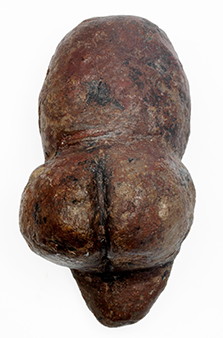

Die Rote von Mauern
In 1948/1949 Lothar Zotz, University of Erlangen, Germany, directed excavations in the the Weinberghöhlen caves, and on 24th August 1948 found the Rote von Mauern, a 72 mm tall, red ochre coloured limestone venus figure, on the outer slope between cavity two and three.
During 1937-38, 1947-49, 1967 and 1974 bone fragments and traces of mammoth, cave bear, woolly rhinoceros, reindeer and 20 other different animals.
Michael Eckstein (1903-1987) conducted research at the Weinberghöhlen and brought a lot of artifacts to the museum in Neuburg. Unfortunately, the caves remain closed due to rock fall hazard.
Photo (left): https://web.de/magazine/wissen/highlights-doppelausstellung-eiszeiten-hamburg-31954442
Photo (right): http://lra-nd-sob.de/index.php?id=1415,95
Usually the venus of Mauern is located in the "Archäologische Staatssammlung München". It stems from the Gravettien, and is 72 mm in length, covered with red ochre, made of limestone.
The leader of the excavations was Professor Dr. Lothar F. Zotz (* 6th December 1899 in Heitersheim; † 1967) a German Prehistorian of the university of Erlangen.
Date of discovery: 24th August 1948. The actual discoverer was Graf Christoff von Vojkffy.
The location of discovery is the Weinberghöhlen (= vineyard caves) near Rennertshofen-Mauern in the Landkreis (District of) Neuburg-Schrobenhausen, Bavaria
Mauern (Rennertshofen)
Coordinates: 48 ° 46 '18 "N, 11 ° 3' 44" E
Population: 242 (30 June 2011)
Zip Code: 86643 86 643
Mauern is a village and parish of the district market of Rennertshofen in the district of Neuburg-Schrobenhausen in Upper Bavaria.
Upper Mauern and its districts are located north-northeast of the capital at the beginning of the Rennertshofen Wellheimer dry valley in the hilly landscape of the Southern Franconian Alb.
The nearby towns south of Mauern are Stepperg , Hatzenhofen and the capital Rennertshofen.
Settlement traces indicate an early settlement of the Mauern area. In the Weinberghöhlen caves are numerous relics of the human past. On the southern outskirts, there were remains of a Neolithic settlement and a Celtic iron-smelting centre. Within today's church was a Roman estate (there is still a Roman grave monument in the church). There are still remnants of a Roman wall in the area.
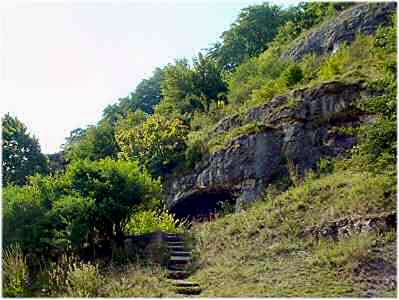
View of the Weinberghöhlen and the steps leading up to it.
Photo: http://www.altmuehltal.de/wellheim/weinberghoehlen.htm

A good photo of the venus, from the excellent Aggsbach's Paleolithic Blog.
Photo: http://www.aggsbach.de/page/8/
Source: Figurine from Mauern (Original: Prähistorische Staatssammlung, München, Germany; Facsimile: Kirchhoff Collection; University Göttingen))
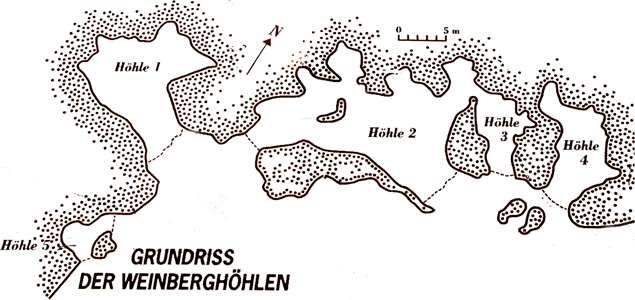
The Weinberghöhlen caves plan.
This shows the metal grids put up to keep visitors from being injured or killed by falling rocks as dotted lines on the plan.
Photo: http://www.kraftvolle-orte.de/uebersicht-der-kraftvollen-orte/hoehlen/mauerner-hoehlen-weinberghoehlen/

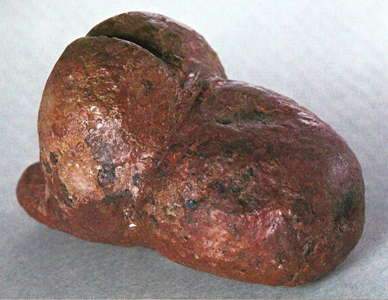
Other views of the Mauern Venus.
Photo: Adam and Kurz (1980)
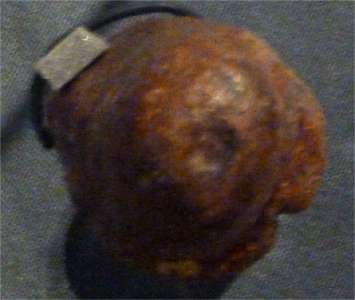
Die Rote von Mauern
Note the depression in the head of the figure. The figure is in some ways enigmatic so far as gender is concerned, it has elements of a phallic figure, and this depression on the head is a possible pointer to its double meaning.
Photo: © Ralph Frenken
Permission: Used by courtesy of Ralph Frenken.
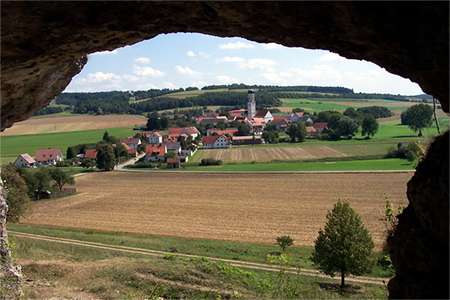
Mauern from the inside of one of the Weinberghöhlen .
From the caves there is a great view of the wide opening of the valley and of approaching prey. During the last ice age people lived in the entrances of the caves and hunted game from there.
The valley in which Mauern is situated has been mostly dry for about 130 000 years, after changes in watercourse drainage occurred.
In the south, the entrance of the Rennertshofen dry valley is very wide, while further north, the valley narrows gradually.
Just past the entrance to the valley lies the small town of Mauern with its high steeple.
Photo: besiwell via Panoramio
Text: Translated and adapted from Kurt Scheuerer, http://www.ingolstadt.de/stadtmuseum/scheuerer/region/weinbrgh.htm
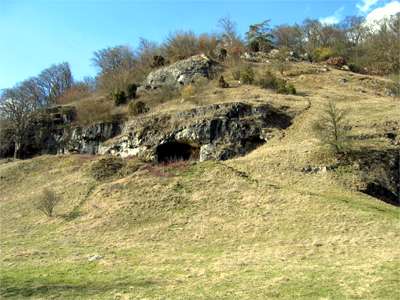
Behind the village you can see from the road in the middle of the western slopes at an altitude of 20 metres above the valley floor, the openings of the Weinberghöhlen caves.
In the ice age summers in the marshy valleys of the Jura there were too many mosquitoes, so the reindeer stayed at the glacier's edge in today's Munich. In the winter, the uplands provided good protection. Therefore in the spring and fall there were migrations of herds across the Danube to the area.
Photo: randyrosy via Panoramio
Text: Translated and adapted from Kurt Scheuerer, http://www.ingolstadt.de/stadtmuseum/scheuerer/region/weinbrgh.htm
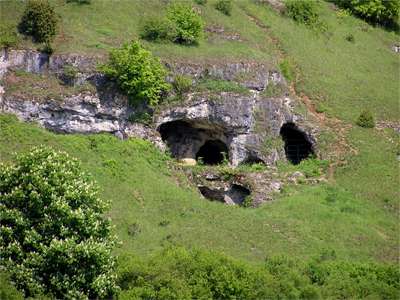
The interior of the caves is now barred, because large blocks spall from the ceiling unexpectedly. The wire mesh can be seen in this photo at the entrance to the cave on the right.
During archaeological investigations in the late 30s, most of the floor of the caves and entrances, several feet thick in places, was excavated. There was hardly anything left for the 1947-1949 follow-up excavation.
The caves are still dangerous. A large block fell unexpectedly and killed a volunteer helping to excavate the Mauern deposits. In his honour a large lime tree was planted at the entrance to the first cave.
In 1977 the Weinberghöhlen had to be barred. No one is able to enter the caves with safety.
Photo: jokreu via Panoramio
The excavations revealed five zones:Text above: Translated and adapted from Kurt Scheuerer, http://www.ingolstadt.de/stadtmuseum/scheuerer/region/weinbrgh.htm
The Gravettian layer yielded some noteworthy findings:
- The lowest layers yielded Mousterian (Neanderthal) stone tools from the middle Palaeolithic during the last ice age.
- The second layer gave "leaf tips" or from the late Middle Palaeolithic, and two storage pits with hearths were found on the forecourts of the lower and upper caves.
- The third layer was sterile, which is also observed in other caves of our region. During this period, it was probably too cold to support human life here.
- Then follow a few sporadic traces of modern man from the earliest Upper Paleolithic culture stage.
- The overlying Gravettian layer showed four different, probably not simultaneous occupations, two of which were longer lasting, in the vestibule of the third cave.
At the entrance to Cave 3, A. Bohmer in 1937/38 found the skull of a juvenile mammoth. In addition, there were several parts of the spine, ribs, shoulder blades and two front leg bone. Another 14 items included a perforated ivory pendant as well as perforated teeth of arctic fox, wolf, bear and reindeer.
A comparable group skeleton was discovered in the previous excavation close by 1937, with a follow-up showed that there were bones of various animals, which had been placed on a layer of red earth in an anatomically correct position.
Outside of the hillside cave between 2 and 3 is also during the excavation by L. Zotz in 1948/49 the statue of a woman, "Rote von Mauern" was found.
All three findings were interspersed with red ochre, which suggests that ritual and spirituality in the ice age was not uncommon.
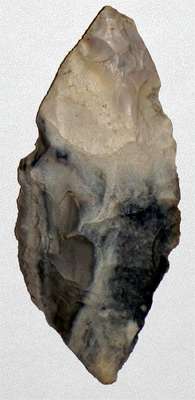
This is one of the famous and extremely fine Blattspitzen or leaf points from Mauern which come from an Interstadial and are clearly associated with middle Paleolithic material.
The Weinberghöhlen near Mauern in Bavaria are one of the most important reference sites for the leaf points-complex in Germany. Two horizons, zone 5 and, above all, zone 4 have yielded bifacial leaf points in the context of a late Mousterian with some affinities to the Keilmessergruppen (Middle European Micoquien) during an Interstadial (Hengelo or earlier during OIS3). Because most of the leaf point-ensembles were excavated many decades ago, contextual data are not available.
Many of these artifacts are highly sophisticated and indicate an advanced level of stone knapping abilities, putatively those of Homo Neanderthaliensis. The function of leaf points is not known (Hunting spear tips, knives, prestigious objects?).
Photo and text: http://www.aggsbach.de/2010/07/middle-paleolithic-leaf-point-from-mauern/
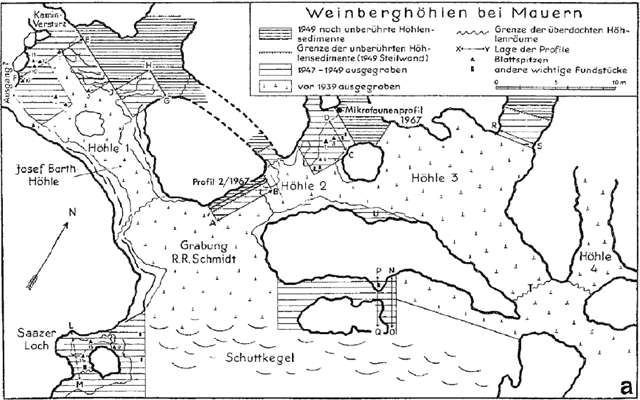
Weinberghöhlen near Mauern (Germany). Plan view of the cave system showing the few tools having been found inside the caves.
After von Koenigswald et al. (1974)
The Weinberghöhlen near Mauern in Bavaria, one of the most important reference
sites for the Blattspitzen complex in Germany, is especially characteristic of
this group of sites. Two horizons, zone 5 and, above all, zone 4 have yielded Blattspitzen. While 609 artifacts, 89 of them tools, came from zone 5, the overlying zone 4 yielded only 398 artifacts, among them 111 tools. Cores and blanks are rare. Both horizons yielded rich faunal remains but according to Wighart von Koenigswald, there is little unambiguous evidence for hunting activities (von Koenigswald et al. 1974). A revised analysis of the fauna from Weinberghöhlen is now being undertaken by P. Krönneck in Tübingen.
It must be stressed that the highest density of finds lay in the entrance areas and
the areas immediately in front of the caves, while inside the caves only isolated
Blattspitzen and a few other artifacts have been found (fig. 7a). In addition, the fire
places were found exclusively outside the caves (fig. 7b).
Photo and text: Bolus (2004)
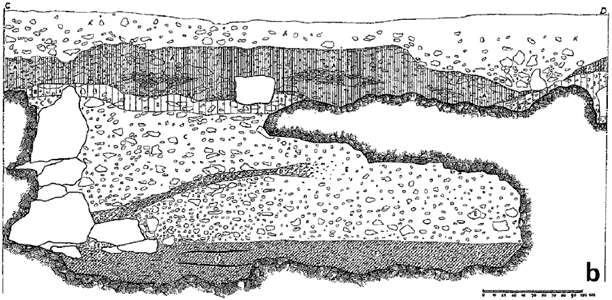
Profile C-D of the entrance area of cave 5 with fire places in the Blattspitzen layer F. After Bohmers (1951)
For the position of the profile see figure 7a above.
It should be stressed that there are strong arguments for the assumption that the
richer layers in the caves, or, in many cases, in front of the caves, are simply the
result of repeated short-term stays, as Hansjürgen Müller-Beck already assumed for
zone 5 of the Weinberghöhlen (von Koenigswald et al. 1974).
This correlates with the fact that cores and evidence for an intensive blank production are rare, that
the proportion of tools is high and that Blattspitzen are dominant among the tools,
which indicates that the assemblages are related to hunting activities. Given that the
areas in front of the caves had not been excavated in Mauern, the find density inside
the caves themselves would show only slight differences to the caves mentioned in
the third group.
Photo and text: Bolus (2004)
Occurrence of mammalia relicts at Weinberghöhlen/Mauern
| Fauna found at the Weinberghöhlen | |
|---|---|
| Scientific Name | Common Name |
| Alopex lagopus | Arctic or Hare-footed Fox |
| Apodemus sp. | Wood Mouse |
| Arvicola terrestris | Water Vole |
| Bos vel Bison | European Bison |
| Canis lupus | Timber Wolf |
| Capra ibex-pyrenaica | Pyrenean Ibex |
| Castor fiber | Eurasian beaver |
| Cervus elaphus | Red Deer |
| Chiroptera sp. | Bat |
| Clethrionomys glareolus | Bank Vole |
| Coelodonta antiquitatis | Woolly Rhinoceros |
| Cricetus cricetus | Common Hamster |
| Crocidura leucodon-russula | Asian Lesser White-toothed Shrew |
| Crocuta crocuta spelaea | Cave Hyena |
| Dicrostonyx torquatus | Arctic Lemming |
| Eliomys quercinus | Garden dormouse |
| Equus sp. | Horse |
| Felis silvestris | Wildcat |
| Glis glis | Fat Dormouse |
| Gulo gulo | Wolverine |
| Lemmus lemmus | Norwegian lemming |
| Lepus sp. | Hare |
| Lepus timidus | Mountain Hare |
| Mammuthus primigenius | Woolly Mammoth |
| Martes martes | European Pine Marten |
| Megaloceros giganteus | Giant Deer, Irish Elk |
| Meles meles | European Badger |
| Microtus arvalis-agrestis | Common Vole, Field Vole |
| Microtus gregalis | Narrow-headed Vole |
| Microtus (Chionomys) nivalis | European Snow Vole |
| Microtus oeconomus | Tundra Vole |
| Mustela erminea | Ermine |
| Mustela nivalis minuta | Dwarf Weasel |
| Neomys fodiens | Eurasian Water Shrew |
| Ochotona pusilla | Steppe Pika |
| Panthera leo spelaea | Cave Lion |
| Putorius eversmanni | Ferret |
| Rangifer tarandus | Reindeer |
| Sicista sp. | Birch Mouse |
| Sorex araneus-alpinus | Common Shrew or Alpine Shrew |
| Sorex kennardi | Shrew |
| Sorex minutus | Pygmy Shrew |
| Spermophilus superciliosus | Ground Squirrel |
| Talpa europaea | European Mole |
| Ursus spelaeus | Cave Bear |
| Vulpes vulpes | Red Fox |
References
- Adam, K., Kurz, R., 1980: Eiszeitkunst im süddeutschen Raum, Theiss.
- Bohmers, A., 1951: Die Höhlen von Mauern I. Kulturgeschichte der altsteinzeitlichen Besiedlung. Palaeohistoria 1. Groningen: J. B. Wolters.
- Bolus M., 2004: Settlement Analysis of Sites of the Blattspitzen Complex in Central Europe. In: J. N. Conard (ed.): Settlement dynamics of the Middle Paleolithic and Middle Stone Age II, 201–226. Tübingen.
- Koenigswald, W. von, Müller-Beck H., and Pressmar E., 1974: Die Archäologie und Paläontologie in den Weinberghöhlen bei Mauern (Bayern). Grabungen 1937-1967Archaeologica Venatoria 3 Tübingen: Institut für Urgeschichte.
- Koenigswald, W. von and Wighart, 1974: Die pleistozäne Fauna der Weinberghöhlen bei MauernArchaeologica Venatoria Tübingen, 3, 53-106
- Rieder , K. et al., 1989: Steinzeitliche Kulturen an Donau und Altmühl, Ingolstadt 1989, p. 50-59.
- Müller-Karpe, H., 1966: Handbuch der Vorgeschichte I, Altsteinzeit, , München 1966, p. 299-301.
